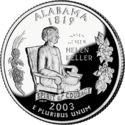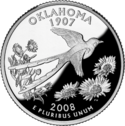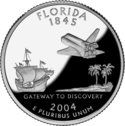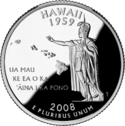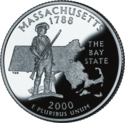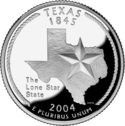Ćwierćdolarówki z 50 amerykańskimi stanami
Ćwierćdolarówki z 50 amerykańskimi stanami – seria monet dwudziestopięciocentowych emitowana przez Mennicę Stanów Zjednoczonych. Seria ta była bita w latach 1999-2008, z pięćdziesięciu różnymi wzorami na rewersie i jednym wspólnym wzorem z podobizną pierwszego prezydenta Jerzego Waszyngtona na awersie[1][2].
Program emisyjny miał stać się pomocą w zainteresowaniu numizmatyką nowej generacji obywateli[3]. Cieszył się wielkim sukcesem i okazał się najlepszym tego typu programem w historii kraju: połowa obywateli Stanów Zjednoczonych zbierała emitowane w tej serii ćwierćdolarówki, zarówno poprzez stały abonament, jak i przypadkowo kolekcjonując monety znajdujące się w obiegu[4]. Bank federalny zarobił 4,6 miliarda dolarów dzięki tzw. rencie emisyjnej[5].
Historia
Projekt programu emisyjnego zrodził się podczas zebrań Obywatelskiego Komitetu Doradczego ds Monet Okolicznościowych (ang. Citizens Commemorative Coin Advisory Committee), który ukonstytuował się w grudniu 1993. Komitet zatwierdził monetę obiegową w 1995. Projekt spotkał się z życzliwym przyjęciem kongresmena Michael N. Castle, który promował ustawę emisyjną w kongresie. Program emisyjny został zatwierdzony przez prezydenta Billa Clintona 1 grudnia 1997. Pierwsza moneta z serii, upamiętniająca stan Delaware, weszła do obiegu w 1999. 51% monet z tej serii było wybitych w mennicy w Filadelfii, zaś pozostałe w mennicy w Denver[6].
Projekt emisyjny
Program zakładał emisję pięciu monet na rok. Symbole konkretnego stanu miały znaleźć się na rewersie monet. Element związany z tradycją lub historią stanu miał być zaprojektowany, jeśli to tylko było możliwe, przez artystę mieszkającego na jego terenie. Każdy z projektów zatwierdzały władze stanowe. Sekwencja emisyjna miała odzwierciedlać kolejność przystępowania stanów do unii[7].
Pod koniec 2008 ukończono emisję wszystkich monet z serii. Wybito w sumie 34 797 600 000 monet. Na każdy ze stanów przypadło średnio 695 952 000 sztuk. Najwięcej monet wybito dla upamiętnienia stanu Virginia – 1 594 616 000, najmniej dla upamiętnienia Oklahomy – 416 600 000. Współczynnik różnicy wyniósł 3,83. Podobną liczbę monet wybito dla stanów Missouri i Wisconsin – około 453 200 000 monet.
Emisja w latach 1999–2008
| Stan | Data emisji (Data przystąpienia do unii) | Liczba | Rewers | Symbol | Grawer |
|---|---|---|---|---|---|
| 1 stycznia 1999 (7 grudnia 1787) | 774 824 000 |  | Caesar Rodney na koniu Napisy: „The First State”, „Caesar Rodney” | William Cousins | |
| 8 marca 1999 (12 grudnia 1787) | 707 332 000 |  | Statua Unii, zarys stanu, zwornik Napis: „Virtue, Liberty, Independence” | John Mercanti | |
| 17 maja 1999 (18 grudnia 1787) | 662 228 000 |  | George Washington przekraczający Delaware według obrazu Emanuela Leutze Napis: „Crossroads of the Revolution” | Alfred Maletsky | |
| 19 lipca 1999 (2 stycznia 1788) | 939 932 000 |  | Brzoskwinia, gałązki dębu wirginijskiego Quercus virginiana (drzewo stanowe), zarys stanu Szarfa z napisem: „Wisdom, Justice, Moderation” (motto stanu) | T. James Ferrell | |
| 12 października 1999 (9 stycznia 1788) | 1 346 624 000 |  | Charter Oak (Dąb biały) Napis: „The Charter Oak” | T. James Ferrell | |
| 3 stycznia 2000 (6 lutego 1788) | 1 163 784 000 |  | Statua minutemana i zarys stanu Napis: „The Bay State” | Thomas D. Rodgers | |
| 13 marca 2000 (28 kwietnia 1788) | 1 234 732 000 |  | Kopuła Maryland State House w Annapolis, gałązki dębu białego (drzewo stanowe) Napis: „The Old Line State” | Thomas D. Rodgers | |
| 22 maja 2000 (23 maja 1788) | 1 308 784 000 |  | Sabal palmetto (drzewo stanowe), strzyżyk karoliński (ptak stanowy), Gelsemium sempervirens (kwiat stanowy), zarys stanu Napis: „The Palmetto State” | Thomas D. Rodgers | |
| 7 sierpnia 2000 (21 czerwca 1788) | 1 169 016 000 |  | Old Man of the Mountain (nieistniejąca formacja skalna w Górach Białych), dziewięć gwiazd Napisy: „Old Man of the Mountain” i „Live Free or Die” | William Cousins | |
| 16 października 2000 (25 czerwca 1788) | 1 594 616 000 |  | Statki: Susan Constant, Godspeed oraz Discovery Napisy: „Jamestown 1607-2007” i „Quadricentennial” | Edgar Z. Steever | |
| 2 stycznia 2001 (26 lipca 1788) | 1 275 040 000 |  | Statua Wolności, jedenaście gwiazd, zarys stanu z zaznaczonymi: rzeką Hudson oraz kanałem Erie Napis: „Gateway to Freedom” | Alfred Maletsky | |
| 12 marca 2001 (21 listopada 1789) | 1 055 476 000 |  | Bracia Wright Napis: „First Flight” | John Mercanti | |
| 21 maja 2001 (29 maja 1790) | 870 100 000 |  | Regaty o Puchar Ameryki: jacht Reliance w Narragansett Bay z mostem Claiborne Pell Newport Bridge Napis: „The Ocean State” | Thomas D. Rodgers | |
| 6 sierpnia 2001 (4 marca 1791) | 882 804 000 |  | Zbieranie soku z klonów cukrowych, góra Camel's Hump Napis: „Freedom and Unity” | T. James Ferrell | |
| 15 października 2001 (1 czerwca 1792) | 723 564 000 |  | Folblutem za ogrodzeniem, Federal Hill w Bardstown Napis: „My Old Kentucky Home” | T. James Ferrell | |
| 2 stycznia 2002 (1 czerwca 1796) | 648 068 000 |  | Skrzypki, trąbka, gitara i partytura oraz trzy gwazdy Wstęga z napisem: „Musical Heritage” | Donna Weaver | |
| 18 marca 2002 (1 marca 1803) | 632 032 000 |  | Lot Flyer I, kosmonauta (Neil Armstrong, ur. w Wapakoneta), zarys stanu Napis: „Birthplace of Aviation Pioneers” | Donna Weaver | |
| 30 maja 2002 (30 kwietnia 1812) | 764 204 000 |  | Pelikan brunatny (ptak stanowy), trąbka z nutami, zarys Zakupu Luizjany z konturem USA w tle Napis: „Louisiana Purchase” | John Mercanti | |
| 8 sierpnia 2002 (11 grudnia 1816) | 689 800 000 |  | Indy Racing League, zarys stanu i 19 gwiazd Napis: „Crossroads of America” | Donna Weaver | |
| 15 października 2002 (10 grudnia 1817) | 579 600 000 |  | Dwa rozwinięte kwiaty magnolii (kwiat stanowy) Napis: „The Magnolia State” | Donna Weaver | |
| 2 stycznia 2003 (3 grudnia 1818) | 463 200 000 |  | Młody Abraham Lincoln, widok farmy, panorama Chicago, zarys stanu i 21 gwiazd Napisy: „Land of Lincoln”, „21st state/century” | Donna Weaver | |
| 17 marca 2003 (14 grudnia 1819) | 457 400 000 |  | Siedząca Helen Keller, gałązka sosny długoigielnej (drzewo stanowe), kwiat magnolii Wstęga z napisem: „Spirit of Courage” oraz napisy „Helen Keller” (drukowany i Braillem) | Norman E. Nemeth | |
| 2 czerwca 2003 (15 marca 1820) | 448 800 000 |  | Latarnia Pemaquid Point w Bristolu, szkuner Victory Chimes[8] na morzu | Donna Weaver | |
| 4 sierpnia 2003 (10 sierpnia 1821) | 453 200 000 |  | Gateway Arch, Lewis i Clark płynący Missouri Napis: „Corps of Discovery 1804-2004” | Alfred Maletsky | |
| 20 października 2003 (15 czerwca 1836) | 457 800 000 |  | Diament (klejnot stanowy), łodygi ryżu, krzyżówka wzlatująca nad taflą | John Mercanti | |
| 26 stycznia 2004 (16 stycznia 1837) | 459 600 000 |  | Zarys stanu i systemu Wielkich Jezior Północnoamerykańskich Napis: „Great Lakes State” | Donna Weaver | |
| 29 marca 2004 (3 marca 1845) | 481 800 000 |  | Hiszpański galeon, Sabal palmetto (drzewo stanowe), prom kosmiczny Napis: „Gateway to Discovery” | T. James Ferrell | |
| 1 czerwca 2004 (29 grudnia 1845) | 541 800 000 |  | Zarys stanu, gwiazda, owalna linia Napis: „The Lone Star State” | Norman E. Nemeth | |
| 30 sierpnia 2004 (28 grudnia 1846) | 465 200 000 |  | Szkoła, nauczycielka i dzieci sadzące drzewo Napisy: „Foundation in Education” i „Grant Wood” | John Mercanti | |
| 25 października 2004 (29 maja 1848) | 453 200 000 |  | Głowa krowy, okrągły ser, kolba kukurydzy (zboże stanowe) Wstęga z napisem: „Forward” | Alfred Maletsky | |
| 31 stycznia 2005 (9 września 1850) | 520 400 000 |  | John Muir, kondor kalifornijski, szczyt Half Dome Napisy: „John Muir” oraz „Yosemite Valley” | Don Everhart | |
| 4 kwietnia 2005 (11 maja 1858) | 488 000 000 |  | Nur lodowiec (ptak stanowy), wędkarstwo, mapa stanu Napis: „Land of 10,000 Lakes” | Charles Vickers | |
| 6 czerwca 2005 (14 lutego 1859) | 720 200 000 |  | Park Narodowy Jeziora Kraterowego Napis: „Crater Lake” | Donna Weaver | |
| 29 sierpnia 2005 (29 stycznia 1861) | 563 400 000 |  | Bizon amerykański (ssak stanowy), słonecznik zwyczajny (kwiat stanowy) | Norman Nemeth | |
| 14 października 2005 (20 czerwca 1863) | 721 600 000 |  | New River Gorge Bridge Napis: „New River Gorge” | John Mercanti | |
| 31 stycznia 2006 (31 października 1864) | 589 800 000 |  | Mustangi, góry, wschodzące słońce, Artemisia tridentata (kwiat stanowy) Wstęga z napisem: „The Silver State” | Don Everhart | |
| 3 kwietnia 2006 (1 marca 1867) | 591 000 000 | Formacja skalna Chimney Rock, Conestoga wagon Napis: „Chimney Rock” | Charles Vickers | ||
| 14 czerwca 2006 (1 sierpnia 1876) | 569 000 000 | Longs Peak Wstęga z napisem: „Colorful Colorado” | Norman Nemeth | ||
| 28 sierpnia 2006 (2 listopada 1889) | 664 800 000 | Bizony, badlandy | Donna Weaver | ||
| 6 listopada 2006 (2 listopada 1889) | 510 800 000 | Mount Rushmore, bażant (ptak stanowy), pszenica (zboże stanowe) | John Mercanti | ||
| 29 stycznia 2007 (8 listopada 1889) | 513 240 000 | Czaszka bizona w centrum z górami i rzeką Missouri w tle Napis: „Big Sky Country” | Don Everhart | ||
| 11 kwietnia 2007 (11 listopada 1889) | 545 200 000 | Łosoś skaczący z wody z Mount Rainier w tle Napis: „The Evergreen State” | Charles Vickers | ||
| 5 czerwca 2007[9] (3 lipca 1890) | 581 400 000 | Sokół wędrowny, wypełniony zarys stanu z gwiazdą Łaciński napis: „Esto perpetua” | Charles Vickers | ||
| 4 września 2007 (10 lipca 1890) | 564 400 000 | Ujeżdżacz koni Napis: „The Equality State” | Norman E. Nemeth | ||
| 5 listopada 2007 (4 stycznia 1896) | 508 200 000 |  | Golden spike i ukończenie Pierwszej Kolei Transkontynentalnej Napis: „Crossroads of the West” | Joseph Menna | |
| 28 stycznia 2008 (16 listopada 1907) | 416 600 000 |  | Tyrannus forficatus (ptak stanowy) z Gaillardia pulchella (dziki kwiat stanowy) w tle | Phebe Hemphill | |
| 7 kwietnia 2008 (6 stycznia 1912) | 488 600 000 |  | Zarys stanu, słoneczny symbol ludu Zia Napis: „Land of Enchantment” | Don Everhart | |
| 2 czerwca 2008 (14 lutego 1912) | 509 600 000 |  | Kanion Kolorado, karnegia olbrzymia Napis: „Grand Canyon State” | Joseph Menna | |
| 23 sierpnia 2008 (3 stycznia 1959) | 505 800 000 |  | Grizli z łososiem (rybą stanową) oraz Gwiazda Polarna Napis: „The Great Land” | Charles Vickers | |
| 3 listopada 2008 (21 sierpnia 1959) | 517 600 000 |  | Statua króla Kamehamehy I z zarysem stanu Motto stanu: „Ua Mau ke Ea o ka ʻĀina i ka Pono” | Don Everhart |
Wartość kolekcjonerska
Podczas gdy liczba wybitych ćwierćdolarówek jest tak różnorodna – monet Wirginii jest prawie dwadzieścia razy więcej niż wybitych w następnej serii monety upamiętniającej Mariany Północne – żadna z tych obiegowych monet nie stała się na tyle rzadką, by osiągnąć znaczącą wartość kolekcjonerską.
Zainteresowanie kolekcjonerów wzbudziła moneta upamiętniająca stan Wisconsin z błędami powstałymi przy biciu monety w mennicy. Niektóre monety posiadają kolbę kukurydzy bez mniejszych liści, niektóre mają listek zakrzywiony ku górze, podczas gdy inne mają liście skierowane ku dołowi[10].
W 2005 wybito ćwierćdolarówki stanu Minnesota z dodatkowymi drzewami. W 2006 pojawiły się monety upamiętniające Kansas ze zgarbionym bizonem. Istnieją też monety Kansas z brakującą literą „T” w napisie, co w efekcie dało wezwanie: „IN GOD WE RUST”[11].
Zobacz też
Przypisy
- ↑ Public Law 105-124-50 States Commemorative Coin Program Act. www.gpo.gov. [dostęp 2010-12-31]. (ang.).
- ↑ Alan Herbert: Warman’s U.S. Coin Collecting. Iola: Krause Publications, 2010, s. 121. ISBN 978-1-4402-1368-7.
- ↑ David L. Ganz: The Official Guidebook to America’s State Quarters. Random House, 2000. (ang.).
- ↑ Matthew Healey: State Quarters Near End of Popular Run. www.nytimes.com, 2007-11-28. [dostęp 2010-12-31]. (ang.).
- ↑ H.R. 902 Presidential $1 Coin Act of 2005. As ordered reported by the House Committee on Financial Services on March 16, 2005. www.cbo.gov, 2005-04-12. [dostęp 2010-12-31]. (ang.).
- ↑ 50 State Quarters Program: Fun Facts & Trivia. coins.thefuntimesguide.com. [dostęp 2010-12-31]. (ang.).
- ↑ The 50 State Quarters® Program. www.usmint.gov. [dostęp 2010-12-31]. (ang.).
- ↑ Nicholas Dean: Schooner Victory Chimes. www.nps.gov, 2002-02-06. [dostęp 2010-12-30]. (ang.).
- ↑ Susan Headley: The Idaho State Quarter. coins.about.com. [dostęp 2010-12-31]. (ang.).
- ↑ Barbara Mikkelson: Cornstalked. www.snopes.com. [dostęp 2010-12-31]. (ang.).
- ↑ Susan Headley: In God We Rust - A State Quarter Error Caused by a Filled Die Strike Through. coins.about.com. [dostęp 2010-12-31]. (ang.).
Linki zewnętrzne
Media użyte na tej stronie
Autor: Rocky Vaughn, Sue Anna Joe, Dominique Pugh, Clay Moss, Kara Giles, and the Mississippi Department of Archives and History, Licencja: Copyrighted free use
The state flag of Mississippi, created in 2020 and adopted in 2021. Known as the "New Magnolia", it was the final design selected by the Commission to Redesign the Mississippi State Flag in 2020.
Flag of California. This version is designed to accurately depict the standard print of the bear as well as adhere to the official flag code regarding the size, position and proportion of the bear, the colors of the flag, and the position and size of the star.
Flag of Utah. Please do not revert to the "21:58, July 26, 2011" or any earlier version, as those versions are factually inaccurate.
Removed background, cropped, and converted to PNG with Macromedia Fireworks.
| This image depicts a unit of currency issued by the United States of America. If this is an image of paper currency or a coin not listed here, it is solely a work of the United States Government, is ineligible for US copyright, and is therefore in the public domain in the United States. Fraudulent use of this image is punishable under applicable counterfeiting laws. As listed by the the U.S. Currency Education Program at money illustrations, the Counterfeit Detection Act of 1992, Public Law 102-550, in Section 411 of Title 31 of the Code of Federal Regulations (31 CFR 411), permits color illustrations of U.S. currency provided: Also: COM:ART #Photograph of an old coin found on the Internet |
Removed background, cropped, and converted to PNG with Macromedia Fireworks.
| This image depicts a unit of currency issued by the United States of America. If this is an image of paper currency or a coin not listed here, it is solely a work of the United States Government, is ineligible for US copyright, and is therefore in the public domain in the United States. Fraudulent use of this image is punishable under applicable counterfeiting laws. As listed by the the U.S. Currency Education Program at money illustrations, the Counterfeit Detection Act of 1992, Public Law 102-550, in Section 411 of Title 31 of the Code of Federal Regulations (31 CFR 411), permits color illustrations of U.S. currency provided: Also: COM:ART #Photograph of an old coin found on the Internet |
Removed background, cropped, and converted to PNG with Macromedia Fireworks.
| This image depicts a unit of currency issued by the United States of America. If this is an image of paper currency or a coin not listed here, it is solely a work of the United States Government, is ineligible for US copyright, and is therefore in the public domain in the United States. Fraudulent use of this image is punishable under applicable counterfeiting laws. As listed by the the U.S. Currency Education Program at money illustrations, the Counterfeit Detection Act of 1992, Public Law 102-550, in Section 411 of Title 31 of the Code of Federal Regulations (31 CFR 411), permits color illustrations of U.S. currency provided: Also: COM:ART #Photograph of an old coin found on the Internet |
Removed background, cropped, and converted to PNG with Macromedia Fireworks.
| This image depicts a unit of currency issued by the United States of America. If this is an image of paper currency or a coin not listed here, it is solely a work of the United States Government, is ineligible for US copyright, and is therefore in the public domain in the United States. Fraudulent use of this image is punishable under applicable counterfeiting laws. As listed by the the U.S. Currency Education Program at money illustrations, the Counterfeit Detection Act of 1992, Public Law 102-550, in Section 411 of Title 31 of the Code of Federal Regulations (31 CFR 411), permits color illustrations of U.S. currency provided: Also: COM:ART #Photograph of an old coin found on the Internet |
Removed background, cropped, and converted to PNG with Macromedia Fireworks. The image of Lincoln is derivative of "The Resolute Lincoln", a statue by Avard Fairbanks
| This image depicts a unit of currency issued by the United States of America. If this is an image of paper currency or a coin not listed here, it is solely a work of the United States Government, is ineligible for US copyright, and is therefore in the public domain in the United States. Fraudulent use of this image is punishable under applicable counterfeiting laws. As listed by the the U.S. Currency Education Program at money illustrations, the Counterfeit Detection Act of 1992, Public Law 102-550, in Section 411 of Title 31 of the Code of Federal Regulations (31 CFR 411), permits color illustrations of U.S. currency provided: Also: COM:ART #Photograph of an old coin found on the Internet |
Alabama state quarter. Removed background, cropped, and converted to PNG with Macromedia Fireworks.
Removed background, cropped, and converted to PNG with Microsoft Photo Editor.
| This image depicts a unit of currency issued by the United States of America. If this is an image of paper currency or a coin not listed here, it is solely a work of the United States Government, is ineligible for US copyright, and is therefore in the public domain in the United States. Fraudulent use of this image is punishable under applicable counterfeiting laws. As listed by the the U.S. Currency Education Program at money illustrations, the Counterfeit Detection Act of 1992, Public Law 102-550, in Section 411 of Title 31 of the Code of Federal Regulations (31 CFR 411), permits color illustrations of U.S. currency provided: Also: COM:ART #Photograph of an old coin found on the Internet |
Removed background, cropped, and converted to PNG with Macromedia Fireworks.
| This image depicts a unit of currency issued by the United States of America. If this is an image of paper currency or a coin not listed here, it is solely a work of the United States Government, is ineligible for US copyright, and is therefore in the public domain in the United States. Fraudulent use of this image is punishable under applicable counterfeiting laws. As listed by the the U.S. Currency Education Program at money illustrations, the Counterfeit Detection Act of 1992, Public Law 102-550, in Section 411 of Title 31 of the Code of Federal Regulations (31 CFR 411), permits color illustrations of U.S. currency provided: Also: COM:ART #Photograph of an old coin found on the Internet |
Maine Statehood Quarter, showing an artist's impression of Pemaquid Point Lighthouse. Removed background, cropped, and converted to PNG with Macromedia Fireworks.
Removed background, cropped, and converted to PNG with Macromedia Fireworks.
Removed background, cropped, and converted to PNG with Macromedia Fireworks.
| This image depicts a unit of currency issued by the United States of America. If this is an image of paper currency or a coin not listed here, it is solely a work of the United States Government, is ineligible for US copyright, and is therefore in the public domain in the United States. Fraudulent use of this image is punishable under applicable counterfeiting laws. As listed by the the U.S. Currency Education Program at money illustrations, the Counterfeit Detection Act of 1992, Public Law 102-550, in Section 411 of Title 31 of the Code of Federal Regulations (31 CFR 411), permits color illustrations of U.S. currency provided: Also: COM:ART #Photograph of an old coin found on the Internet |
Flag of Oregon (obverse): The flag was adopted by the state on February 26, 1925.[1] The state seal was decided in 1903.[2][3]
Removed background, cropped, and converted to PNG with Macromedia Fireworks.
| This image depicts a unit of currency issued by the United States of America. If this is an image of paper currency or a coin not listed here, it is solely a work of the United States Government, is ineligible for US copyright, and is therefore in the public domain in the United States. Fraudulent use of this image is punishable under applicable counterfeiting laws. As listed by the the U.S. Currency Education Program at money illustrations, the Counterfeit Detection Act of 1992, Public Law 102-550, in Section 411 of Title 31 of the Code of Federal Regulations (31 CFR 411), permits color illustrations of U.S. currency provided: Also: COM:ART #Photograph of an old coin found on the Internet |
Removed background, cropped, and converted to PNG with Macromedia Fireworks.
| This image depicts a unit of currency issued by the United States of America. If this is an image of paper currency or a coin not listed here, it is solely a work of the United States Government, is ineligible for US copyright, and is therefore in the public domain in the United States. Fraudulent use of this image is punishable under applicable counterfeiting laws. As listed by the the U.S. Currency Education Program at money illustrations, the Counterfeit Detection Act of 1992, Public Law 102-550, in Section 411 of Title 31 of the Code of Federal Regulations (31 CFR 411), permits color illustrations of U.S. currency provided: Also: COM:ART #Photograph of an old coin found on the Internet |
Removed background, cropped, and converted to PNG with Macromedia Fireworks.
| This image depicts a unit of currency issued by the United States of America. If this is an image of paper currency or a coin not listed here, it is solely a work of the United States Government, is ineligible for US copyright, and is therefore in the public domain in the United States. Fraudulent use of this image is punishable under applicable counterfeiting laws. As listed by the the U.S. Currency Education Program at money illustrations, the Counterfeit Detection Act of 1992, Public Law 102-550, in Section 411 of Title 31 of the Code of Federal Regulations (31 CFR 411), permits color illustrations of U.S. currency provided: Also: COM:ART #Photograph of an old coin found on the Internet |
Removed background, cropped, and converted to PNG with Macromedia Fireworks.
Removed background, cropped, and converted to PNG with Microsoft Photo Editor.
| This image depicts a unit of currency issued by the United States of America. If this is an image of paper currency or a coin not listed here, it is solely a work of the United States Government, is ineligible for US copyright, and is therefore in the public domain in the United States. Fraudulent use of this image is punishable under applicable counterfeiting laws. As listed by the the U.S. Currency Education Program at money illustrations, the Counterfeit Detection Act of 1992, Public Law 102-550, in Section 411 of Title 31 of the Code of Federal Regulations (31 CFR 411), permits color illustrations of U.S. currency provided: Also: COM:ART #Photograph of an old coin found on the Internet |
Removed background, cropped, and converted to PNG with Macromedia Fireworks.
| This image depicts a unit of currency issued by the United States of America. If this is an image of paper currency or a coin not listed here, it is solely a work of the United States Government, is ineligible for US copyright, and is therefore in the public domain in the United States. Fraudulent use of this image is punishable under applicable counterfeiting laws. As listed by the the U.S. Currency Education Program at money illustrations, the Counterfeit Detection Act of 1992, Public Law 102-550, in Section 411 of Title 31 of the Code of Federal Regulations (31 CFR 411), permits color illustrations of U.S. currency provided: Also: COM:ART #Photograph of an old coin found on the Internet |
Removed background, cropped, and converted to PNG with Macromedia Fireworks.
| This image depicts a unit of currency issued by the United States of America. If this is an image of paper currency or a coin not listed here, it is solely a work of the United States Government, is ineligible for US copyright, and is therefore in the public domain in the United States. Fraudulent use of this image is punishable under applicable counterfeiting laws. As listed by the the U.S. Currency Education Program at money illustrations, the Counterfeit Detection Act of 1992, Public Law 102-550, in Section 411 of Title 31 of the Code of Federal Regulations (31 CFR 411), permits color illustrations of U.S. currency provided: Also: COM:ART #Photograph of an old coin found on the Internet |
Removed background, cropped, and converted to PNG with Macromedia Fireworks.
| This image depicts a unit of currency issued by the United States of America. If this is an image of paper currency or a coin not listed here, it is solely a work of the United States Government, is ineligible for US copyright, and is therefore in the public domain in the United States. Fraudulent use of this image is punishable under applicable counterfeiting laws. As listed by the the U.S. Currency Education Program at money illustrations, the Counterfeit Detection Act of 1992, Public Law 102-550, in Section 411 of Title 31 of the Code of Federal Regulations (31 CFR 411), permits color illustrations of U.S. currency provided: Also: COM:ART #Photograph of an old coin found on the Internet |
Removed background, cropped, and converted to PNG with Macromedia Fireworks.
| This image depicts a unit of currency issued by the United States of America. If this is an image of paper currency or a coin not listed here, it is solely a work of the United States Government, is ineligible for US copyright, and is therefore in the public domain in the United States. Fraudulent use of this image is punishable under applicable counterfeiting laws. As listed by the the U.S. Currency Education Program at money illustrations, the Counterfeit Detection Act of 1992, Public Law 102-550, in Section 411 of Title 31 of the Code of Federal Regulations (31 CFR 411), permits color illustrations of U.S. currency provided: Also: COM:ART #Photograph of an old coin found on the Internet |
Removed background, cropped, and converted to PNG with Macromedia Fireworks.
Removed background, cropped, and converted to PNG with Macromedia Fireworks.
| This image depicts a unit of currency issued by the United States of America. If this is an image of paper currency or a coin not listed here, it is solely a work of the United States Government, is ineligible for US copyright, and is therefore in the public domain in the United States. Fraudulent use of this image is punishable under applicable counterfeiting laws. As listed by the the U.S. Currency Education Program at money illustrations, the Counterfeit Detection Act of 1992, Public Law 102-550, in Section 411 of Title 31 of the Code of Federal Regulations (31 CFR 411), permits color illustrations of U.S. currency provided: Also: COM:ART #Photograph of an old coin found on the Internet |
Removed background, cropped, and converted to PNG with Microsoft Photo Editor.
| This image depicts a unit of currency issued by the United States of America. If this is an image of paper currency or a coin not listed here, it is solely a work of the United States Government, is ineligible for US copyright, and is therefore in the public domain in the United States. Fraudulent use of this image is punishable under applicable counterfeiting laws. As listed by the the U.S. Currency Education Program at money illustrations, the Counterfeit Detection Act of 1992, Public Law 102-550, in Section 411 of Title 31 of the Code of Federal Regulations (31 CFR 411), permits color illustrations of U.S. currency provided: Also: COM:ART #Photograph of an old coin found on the Internet |
Removed background, cropped, and converted to PNG with Macromedia Fireworks.
| This image depicts a unit of currency issued by the United States of America. If this is an image of paper currency or a coin not listed here, it is solely a work of the United States Government, is ineligible for US copyright, and is therefore in the public domain in the United States. Fraudulent use of this image is punishable under applicable counterfeiting laws. As listed by the the U.S. Currency Education Program at money illustrations, the Counterfeit Detection Act of 1992, Public Law 102-550, in Section 411 of Title 31 of the Code of Federal Regulations (31 CFR 411), permits color illustrations of U.S. currency provided: Also: COM:ART #Photograph of an old coin found on the Internet |
Removed background, cropped, and converted to PNG with Macromedia Fireworks.
| This image depicts a unit of currency issued by the United States of America. If this is an image of paper currency or a coin not listed here, it is solely a work of the United States Government, is ineligible for US copyright, and is therefore in the public domain in the United States. Fraudulent use of this image is punishable under applicable counterfeiting laws. As listed by the the U.S. Currency Education Program at money illustrations, the Counterfeit Detection Act of 1992, Public Law 102-550, in Section 411 of Title 31 of the Code of Federal Regulations (31 CFR 411), permits color illustrations of U.S. currency provided: Also: COM:ART #Photograph of an old coin found on the Internet |
The reverse side of the Kentucky State Quarter. It is a "proof" obtained from the US Mint website and has its background removed, was cropped, and converted to PNG with Macromedia Fireworks.
Removed background, cropped, and converted to PNG with Macromedia Fireworks.
| This image depicts a unit of currency issued by the United States of America. If this is an image of paper currency or a coin not listed here, it is solely a work of the United States Government, is ineligible for US copyright, and is therefore in the public domain in the United States. Fraudulent use of this image is punishable under applicable counterfeiting laws. As listed by the the U.S. Currency Education Program at money illustrations, the Counterfeit Detection Act of 1992, Public Law 102-550, in Section 411 of Title 31 of the Code of Federal Regulations (31 CFR 411), permits color illustrations of U.S. currency provided: Also: COM:ART #Photograph of an old coin found on the Internet |
Flag of the State of Nevada. The flag is described in Nevada Revised Statutes Chapter 235, Sec. 20 as follows: The body of the flag must be of solid cobalt blue. On the field in the upper left quarter thereof must be two sprays of Sagebrush with the stems crossed at the bottom to form a half wreath. Within the sprays must be a five-pointed silver star with one point up. The word “Nevada” must also be inscribed below the star and above the sprays, in a semicircular pattern with the letters spaced apart in equal increments, in the same style of letters as the words “Battle Born.” Above the wreath, and touching the tips thereof, must be a scroll bearing the words “Battle Born.” The scroll and the word “Nevada” must be golden-yellow. The lettering on the scroll must be black-colored sans serif gothic capital letters.
Removed background, cropped, and converted to PNG with Macromedia Fireworks.
| This image depicts a unit of currency issued by the United States of America. If this is an image of paper currency or a coin not listed here, it is solely a work of the United States Government, is ineligible for US copyright, and is therefore in the public domain in the United States. Fraudulent use of this image is punishable under applicable counterfeiting laws. As listed by the the U.S. Currency Education Program at money illustrations, the Counterfeit Detection Act of 1992, Public Law 102-550, in Section 411 of Title 31 of the Code of Federal Regulations (31 CFR 411), permits color illustrations of U.S. currency provided: Also: COM:ART #Photograph of an old coin found on the Internet |
Removed background, cropped, and converted to PNG with Microsoft Photo Editor.
| This image depicts a unit of currency issued by the United States of America. If this is an image of paper currency or a coin not listed here, it is solely a work of the United States Government, is ineligible for US copyright, and is therefore in the public domain in the United States. Fraudulent use of this image is punishable under applicable counterfeiting laws. As listed by the the U.S. Currency Education Program at money illustrations, the Counterfeit Detection Act of 1992, Public Law 102-550, in Section 411 of Title 31 of the Code of Federal Regulations (31 CFR 411), permits color illustrations of U.S. currency provided: Also: COM:ART #Photograph of an old coin found on the Internet |
Removed background, cropped, and converted to PNG with Macromedia Fireworks.
Removed background, cropped, and converted to PNG with Macromedia Fireworks.
| This image depicts a unit of currency issued by the United States of America. If this is an image of paper currency or a coin not listed here, it is solely a work of the United States Government, is ineligible for US copyright, and is therefore in the public domain in the United States. Fraudulent use of this image is punishable under applicable counterfeiting laws. As listed by the the U.S. Currency Education Program at money illustrations, the Counterfeit Detection Act of 1992, Public Law 102-550, in Section 411 of Title 31 of the Code of Federal Regulations (31 CFR 411), permits color illustrations of U.S. currency provided: Also: COM:ART #Photograph of an old coin found on the Internet |
Removed background, cropped, and converted to PNG with Macromedia Fireworks.
| This image depicts a unit of currency issued by the United States of America. If this is an image of paper currency or a coin not listed here, it is solely a work of the United States Government, is ineligible for US copyright, and is therefore in the public domain in the United States. Fraudulent use of this image is punishable under applicable counterfeiting laws. As listed by the the U.S. Currency Education Program at money illustrations, the Counterfeit Detection Act of 1992, Public Law 102-550, in Section 411 of Title 31 of the Code of Federal Regulations (31 CFR 411), permits color illustrations of U.S. currency provided: Also: COM:ART #Photograph of an old coin found on the Internet |
Removed background, cropped, and converted to PNG with Macromedia Fireworks.
| This image depicts a unit of currency issued by the United States of America. If this is an image of paper currency or a coin not listed here, it is solely a work of the United States Government, is ineligible for US copyright, and is therefore in the public domain in the United States. Fraudulent use of this image is punishable under applicable counterfeiting laws. As listed by the the U.S. Currency Education Program at money illustrations, the Counterfeit Detection Act of 1992, Public Law 102-550, in Section 411 of Title 31 of the Code of Federal Regulations (31 CFR 411), permits color illustrations of U.S. currency provided: Also: COM:ART #Photograph of an old coin found on the Internet |
Removed background, cropped, and converted to PNG with Microsoft Photo Editor.
| This image depicts a unit of currency issued by the United States of America. If this is an image of paper currency or a coin not listed here, it is solely a work of the United States Government, is ineligible for US copyright, and is therefore in the public domain in the United States. Fraudulent use of this image is punishable under applicable counterfeiting laws. As listed by the the U.S. Currency Education Program at money illustrations, the Counterfeit Detection Act of 1992, Public Law 102-550, in Section 411 of Title 31 of the Code of Federal Regulations (31 CFR 411), permits color illustrations of U.S. currency provided: Also: COM:ART #Photograph of an old coin found on the Internet |
On May 10, 2006, on the anniversary of the driving of the spike, Utah announced that its state quarter design would be a depiction of the driving of the spike. The Golden Spike design was selected as the winner from among several others by Utah's governor, Jon Huntsman, Jr., following a period during which Utah residents voted and commented on their favorite of three finalists.
2004 U.S. commemorative quarter, with a Texas symbol
Removed background, cropped, and converted to PNG with Macromedia Fireworks.
| This image depicts a unit of currency issued by the United States of America. If this is an image of paper currency or a coin not listed here, it is solely a work of the United States Government, is ineligible for US copyright, and is therefore in the public domain in the United States. Fraudulent use of this image is punishable under applicable counterfeiting laws. As listed by the the U.S. Currency Education Program at money illustrations, the Counterfeit Detection Act of 1992, Public Law 102-550, in Section 411 of Title 31 of the Code of Federal Regulations (31 CFR 411), permits color illustrations of U.S. currency provided: Also: COM:ART #Photograph of an old coin found on the Internet |
Removed background, cropped, and converted to PNG with Macromedia Fireworks.
| This image depicts a unit of currency issued by the United States of America. If this is an image of paper currency or a coin not listed here, it is solely a work of the United States Government, is ineligible for US copyright, and is therefore in the public domain in the United States. Fraudulent use of this image is punishable under applicable counterfeiting laws. As listed by the the U.S. Currency Education Program at money illustrations, the Counterfeit Detection Act of 1992, Public Law 102-550, in Section 411 of Title 31 of the Code of Federal Regulations (31 CFR 411), permits color illustrations of U.S. currency provided: Also: COM:ART #Photograph of an old coin found on the Internet |
Removed background, cropped, and converted to PNG with Macromedia Fireworks.
| This image depicts a unit of currency issued by the United States of America. If this is an image of paper currency or a coin not listed here, it is solely a work of the United States Government, is ineligible for US copyright, and is therefore in the public domain in the United States. Fraudulent use of this image is punishable under applicable counterfeiting laws. As listed by the the U.S. Currency Education Program at money illustrations, the Counterfeit Detection Act of 1992, Public Law 102-550, in Section 411 of Title 31 of the Code of Federal Regulations (31 CFR 411), permits color illustrations of U.S. currency provided: Also: COM:ART #Photograph of an old coin found on the Internet |

























